|
Acrocephalus gracilirostris
(Lesser swamp-warbler, Cape reed-warbler)
Kaapse rietsanger [Afrikaans]; Niini (generic term for
warblers and eremomelas) [Kwangali]; Soamahlaka-ntšitšoeu [South Sotho];
Timba (generic name for cisticolas and warblers) [Shona]; Kaapse
rietzanger [Dutch]; Rousserolle à bec fin [French]; Kaprohrsänger
[German]; Rouxinol-pequeno-dos-pântanos [Portuguese]
Life
> Eukaryotes >
Opisthokonta
> Metazoa (animals) >
Bilateria >
Deuterostomia > Chordata >
Craniata > Vertebrata (vertebrates) > Gnathostomata (jawed
vertebrates) > Teleostomi (teleost fish) > Osteichthyes (bony fish) > Class:
Sarcopterygii (lobe-finned
fish) > Stegocephalia (terrestrial
vertebrates) > Tetrapoda
(four-legged vertebrates) > Reptiliomorpha > Amniota >
Reptilia (reptiles) >
Romeriida > Diapsida > Archosauromorpha > Archosauria >
Dinosauria
(dinosaurs) > Saurischia > Theropoda (bipedal predatory dinosaurs) >
Coelurosauria > Maniraptora > Aves
(birds) > Order: Passeriformes
> Family: Sylviidae > Genus: Acrocephalus
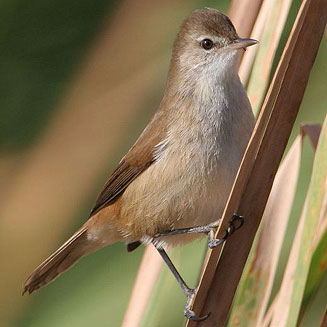 |
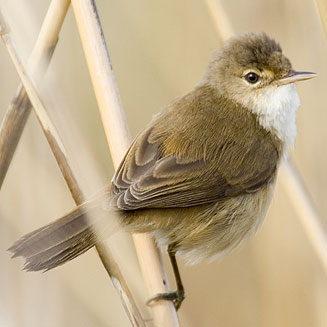 |
| Lesser swamp-warbler, Paarl Bird
Sancutary, South Africa. [photo Trevor Hardaker ©] |
Lesser swamp-warbler. [photo
Johann du Preez
©] |
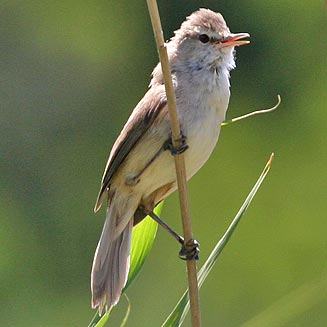 |
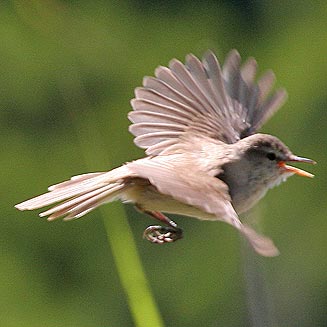 |
| Lesser swamp-warbler, West Coast Fossil Park, Western Cape, South Africa. [photo H. Robertson,
Iziko ©] |
Lesser swamp-warbler, West Coast Fossil Park, Western Cape, South Africa. [photo H. Robertson,
Iziko ©] |
Distribution and habitat
Occurs from East Africa through Tanzania, Zambia and
northern Mozambique to southern Africa. It is quite habitat specific, preferring
reeds (Phragmites) and Bulrushes (Typha capensis) in lagoons,
estuaries, marshes, rivers and man-made impoundments.
|
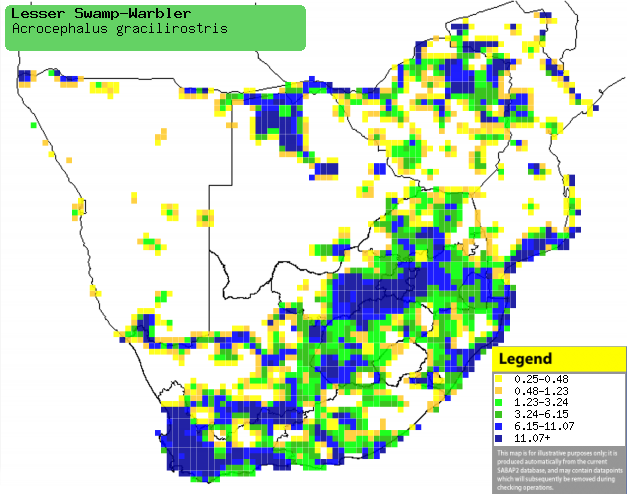 |
|
Distribution of Lesser swamp-warbler in southern
Africa, based on statistical smoothing of the records from first SA Bird
Atlas Project (©
Animal Demography unit, University of
Cape Town; smoothing by Birgit Erni and Francesca Little). Colours range
from dark blue (most common) through to yellow (least common).
See here for the latest distribution
from the SABAP2. |
Food
It does most of its foraging near the water surface, nimbly
gleaning invertebrates from reed stems. It also takes food from the leaf litter
and tree foliage on the banks of the water body, and it may even forage in the
tree canopy.
Breeding
- The nest is constructed solely by the female, who collects plant debris
from the ground and rips off parts of reed stems. Using these she weaves
together a neat, cone-shaped cup, strung between 2-3 reed stems typically
within 1 metre of the water surface.
- Egg-laying season is from August-May, peaking from October-February.
- It lays 2-3 eggs, which are incubated by both sexes for about 13-14
days.
- The chicks are fed by both adults, leaving the nest after about 10-14
days.
Threats
Not threatened.
References
-
Hockey PAR, Dean WRJ and Ryan PG 2005. Roberts
- Birds of southern Africa, VIIth ed. The Trustees of the John Voelcker
Bird Book Fund, Cape Town.
-
Harrison, J.A., Allan, D.G., Underhill, L.G., Herremans, M.,
Tree. A.J., Parker, V. & Brown, C.J. (eds). 1997. The atlas of southern
African birds. Vol. 2: Passerines. BirdLife South Africa, Johannesburg.
|
